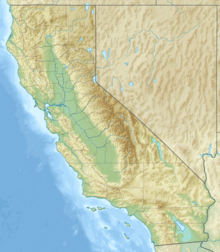Griswold Hills facts for kids
Quick facts for kids Griswold Hills |
|
|---|---|
| Highest point | |
| Elevation | 785 m (2,575 ft) |
| Geography | |
| Country | United States |
| State | California |
| District | San Benito County |
| Range coordinates | 36°31′24.836″N 120°44′0.630″W / 36.52356556°N 120.73350833°W |
| Topo map | USGS Tumey Hills |
The Griswold Hills are a low mountain range found in central California. They are part of a larger system called the Southern Inner California Coast Ranges. You can find them in the southeastern part of San Benito County.
These hills are located to the east of the Diablo Range. They sit on the western edge of the wide San Joaquin Valley. The Griswold Hills also help define the southern boundary of the Panoche Valley.
Contents
Griswold Hills: A California Mountain Range
The Griswold Hills are not as tall as some famous mountains. They are considered a "low mountain range." This means their peaks are generally lower in elevation. The highest point in the Griswold Hills reaches about 785 meters (or 2,575 feet) above sea level.
These hills are an important part of California's natural landscape. They show how different landforms connect across the state. Understanding these smaller ranges helps us learn about the bigger picture of California's geography.
Where Are the Griswold Hills?
The Griswold Hills are located in a specific part of California. They are in San Benito County, which is in the central part of the state. Imagine looking at a map of California. You would find these hills roughly in the middle, but a bit closer to the coast.
They are positioned between two larger natural features. To their west is the Diablo Range, a much larger mountain chain. To their east is the vast San Joaquin Valley, a major agricultural area. The hills act like a natural border between these two different regions. They also form the southern edge of the Panoche Valley, a smaller valley known for its unique environment.
What Makes Up the Griswold Hills?
Like all mountain ranges, the Griswold Hills were formed over millions of years. They are part of the California Coast Ranges. This system formed as large pieces of the Earth's crust, called tectonic plates, slowly moved and crashed into each other. This process pushed up the land, creating hills and mountains.
The rocks in the Griswold Hills tell a story of ancient times. They show how the land has changed over long periods. Geologists study these rocks to understand the history of the Earth in this region. The hills are a great example of how natural forces shape our planet.
Plants and Animals of the Hills
Even though they are low hills, the Griswold Hills are home to various plants and animals. The climate in this part of California is often dry. This means the plants and animals living here must be tough. They have adapted to survive with less water.
You might find plants like chaparral shrubs or various types of grasses. These plants are common in California's dry hills. They provide food and shelter for local wildlife. The types of animals you might see include small mammals, birds, and reptiles. These creatures are well-suited to the hilly, dry environment.
Life Cycles in the Hills
The plants and animals in the Griswold Hills follow natural life cycles. Plants grow from seeds, bloom, and then produce new seeds. This cycle helps them spread and survive. Many plants here have special ways to cope with dry spells. Some have deep roots, while others store water in their leaves.
Animals also have their own life cycles. They are born, grow, reproduce, and then pass on their genes. For example, birds build nests and raise their young in the hills. Reptiles lay eggs, and their babies hatch and grow. These cycles are important for keeping the ecosystem healthy and balanced.
Exploring the Griswold Hills
The Griswold Hills offer a chance to connect with nature. While they might not be as famous as taller mountains, they provide important habitats. They are a place where you can observe California's unique landscape.
People who visit the area might enjoy hiking or birdwatching. It's a great spot to see local wildlife and native plants. The hills are a reminder of the natural beauty found throughout California. They show that even smaller geographical features play a big role in our environment.


